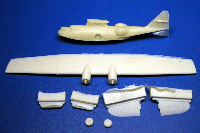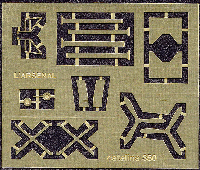PBY-5A Catalina

Reviewed by Sean Hert

| HISTORY | |||||||||||||||||||
|
One of the effects of the Washington Conference of 1921-22 was the limits placed upon the United States' ability to develop and fortify forward bases in the Pacific and the impact on the plans of War Plan Orange. Planners in the Navy were required to starting thinking of longer distances between secure bases, necessitating ships and aircraft with ranges much greater than considered before. A long range patrol bomber and scouting aircraft which could operate independantly of airfields or complex basing requirements was needed, and a flying boat suited these purposes well. The Navy invested millions of dollars developing a variety of flying boats from various manufacturers- but one aircraft stands out among the rest; the Consolidated PBY Catalina. The Consolidated Aircraft company began production of the Catalina in 1936, and this aircraft was continually produced for almost 10 years. Approximately 4,00 of these flying boats in total were built, in almost 30 different variants. These aircraft were used by almost all the various Allied forces, and were license-built in Canada and Soviet Union. These flying boats became famous for both the exploits of the "Black Cat" squadrons in the South Pacific early in World War Two, as well as their role in the rescue of downed air crew at sea- and let's not forget the role played by an RAF Coastal Command Catalina in spotting the German Battleship Bismarck on 26 May 1941. |
|||||||||||||||||||
| PARTS | |||||||||||||||||||
|
The bulk of this kit is comprised of 8 resin parts; wing, fuselage, wing-tip floats (2), horizontal stabilizers (2), and main gear wheels (2). All the parts are well done; the floats and stabilizers are cast onto blocks, and all these parts have very little flash. What flash is present is paper thin, and quite easy to detach. These parts have good detail; the wheels have hubs with spokes, the canopy has raised lines for the frame, and even the bombardier's nose window is there. The single-part wing has a slight bend to it, one that a bath in some hot water should fix. |
|||||||||||||||||||
 |
|||||||||||||||||||
|
|||||||||||||||||||
| PHOTOETCH | |||||||||||||||||||
|
There is a small fret of photoetched parts for this Catalina. These are not optional detail pieces to upgrade kit parts, like seen on a commercial plastic model, but detailed necessary parts to complete the build. These parts include propellers for the twin radials, and the two wing struts per side. The wing struts have the tapered fairings built into the shape. This fret also gives the builder the option to model their Cat' with the landing gear deployed or the floats deployed. In the landing gear down configuration, there is etched nose gear parts, and nose well doors, as well as main gear struts for the resin wheels. For the floats down version, appropriate for water landings (great diorama opportunities) there are etched V Struts and Inverse V Struts for the wingtip floats (the activating arm is missing). The Inverse V Strut will also be used in the gear down configuration, only mounted flush with the wing. |
 |
||||||||||||||||||
| DECAL | |||||||||||||||||||
|
There are no decals included in this kit. |
|||||||||||||||||||
| INSTRUCTIONS | |||||||||||||||||||
A single double-sides sheet of instructions is included- and all that is really needed. | |||||||||||||||||||
|
|||||||||||||||||||
| CONCLUSIONS | |||||||||||||||||||


What a great little kit of this important plane. Many diorama possibilities, from all theatres of the war! Thanks to L'Arsenal USA for providing us with this review sample. This is kit #AC 350-80 PBY-5A Catalina 1/350, priced at $11.00. Available direct from L'Arsenal, L'Arsenal USA or wherever fine ship accessories are sold. |
|||||||||||||||||||
